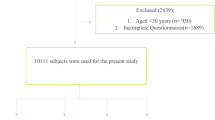Abstract
In the present investigation, the data sets of NCD (Non Communicable Diseases) risk factors, a standard report of Saudi Arabia 2005, in collaboration with WHO (World Health Organisation) were employed. The Oracle Data Miner (ODM) tool was used for the analysis and prediction of data. The data sets for different age groups in case of blood pressure treatment for hypertension for male using different modes had been studied. The age group was in between of 15 and 64 years. Data mining had been an appropriate and sufficiently sensitive method to analyze the outcomes of which mode of treatment is more effective to which age group. The five age group of NCD data had been put into two age groups of young and old denoted as ‘Y’ and ‘O’ respectively. Data mining showed that all the five modes of treatments were effective for older people due to hypertension at older ages.
Similar content being viewed by others
References
ALLHAT Officers and Coordinators for the ALLHAT Collaborative Research Group. Major outcomes in high-risk hypertensive patients randomized to angiotensin-converting enzyme inhibitor or calcium channel blocker vs diuretic: the antihypertensive and lipid lowering treatment to prevent heart attack trial (ALLHAT). JAMA. 2002;288:2981–97.
Al-Nozha MM, Osman AK. The prevalence of hypertension in different geographical regions of Saudi Arabia. Ann Saudi Med. 1998;18:401–7.
Al-Nozha MM, Ali MS, Osman AK. Arterial hypertension in Saudi Arabia. Ann Saudi Med. 1997;17:170–4.
Al-Nozha MM, Abdullah M, Arafah MR. Khalil MZ, Khan NB, Al-Mazrou YY, Al-Maatouq MA, Al-Marzouki K, Al-Khadra A, Nouh MS, Al-Harthi SS, Al-Shahid MS, Al Mobeireek A. Hypertension in Saudi Arabia. Saudi Med J. 2007;28(1):77–84. ISSN 0379-5284 [8 page(s) (article)] (41 ref.).
Anderson J, Young L, Long E. Diet and hypertension. Health food and nutrition series. 2008. Colorado State University vol 9.318 (revised 8/2008).
Bryg RJ. Revised on March 06, 2009. An overview of high blood pressure treatment. 2009. Obtained through the Inter net: http://www.webmd.com/hypertension-high-bloodpressure/guide/hypertension-treatment-overview. Accessed 26/3/2010.
Chobanaian AV, Bakris GL, Black HR, Cushman WC. The Seventh Report of the Joint National Committee on prevention, detection, evaluation, treatment of high blood pressure: the JNC 7 report. JAMA. 2003;289:2560.
Critchley J, Capewell S. Smoking cessation for the secondary prevention of coronary heart disease. Cochrane Database Syst Rev. 2004;CD003041.
Effective matters, vol 4, issue 2, Oct 1999, the University of York. Obtains through the Internet: http://www.york.ac.uk/inst/crd/EM/em42.pdf. Accessed 26/3/2010.
El-Hazmi MA, Warsy AS. Hypertension in Saudi Arabia. Saudi J Kidney Dis Transpl. 1999;10:365–71.
Fagard RH, Cornelissen VA. Effect of exercise on blood pressure control in hypertensive patients. Eur J Cardiovasc Prev Rehabil. 2007;14:12–7.
Goldstein I, Uzunor O. Specializing for predicting obesity and its co-morbidites. J Biomed Inform. 2009;42:873–86.
Mancia G, De Backer G, Dominiczak A, Cifkova R, Fagard R, Germano G, et al. ‘Guidelines for the management of arterial hypertension’. The task force for the management of arterial hypertension of the European Society of Hypertension (ESH) and of the European Society of Cardiology (ESC). J Hypertens. 2007;25:1105–87.
Ministry of Health, Saudi Arabia, Saudi hypertension management guidelines. 2007, ISBN: 9960-9518-6-3.
National Heart Foundation of Australia. Guide to management of hypertension. Assessing and managing raised blood pressure in adults. 2008. Obtained through the Internet: http://www.heartfoundation.org.au/Professional_Information/Clinical_Practice/Hypertension.htm. Accessed 25/3/2010.
Nazim Uddin K. Prevalence of hypertension in Saudi Arabia. Practitioner East Mediterr Ed. 1994;1994:805–6.
Oracle Data Mining Documentation obtains through the Internet: http://www.oracle.com/technology/documentation/datamining.html. Accessed 02/2/2010.
Oracle Technology Network obtain tool. Obtained through Internet: http://www.oracle.com/technology/products/bi/odm/odminer.html. Accessed 10/2/2010.
World Health Organisation, NCD risk factor, standard report of Ministry of Health, Saudi Arabia. 2005. Obtained through the Internet: http://www.who.int/research/en/. Accessed 15/12/2009.
Author information
Authors and Affiliations
Corresponding author
Additional information
Almazyad AS, Ahamad MG, Siddiqui MK, Almazyad AS. Effective hypertensive treatment using data mining in Saudi Arabia.
Rights and permissions
About this article
Cite this article
Almazyad, A.S., Ahamad, M.G., Siddiqui, M.K. et al. Effective hypertensive treatment using data mining in Saudi Arabia. J Clin Monit Comput 24, 391–401 (2010). https://doi.org/10.1007/s10877-010-9260-2
Received:
Accepted:
Published:
Issue Date:
DOI: https://doi.org/10.1007/s10877-010-9260-2




